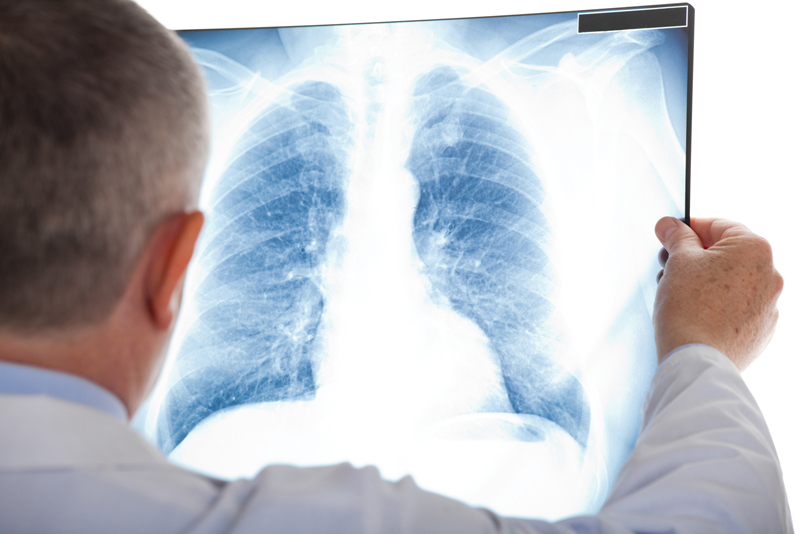The Leading Cause of Cancer Death
Lung cancer strikes both smokers and nonsmokers.

The high-profile news that Dana Reeve, widow of actor Christopher Reeve, was diagnosed with lung cancer in 2005 came as a complete surprise to the public, mainly because she was a nonsmoker.
“I think most people think it’s only smokers that get lung cancer, which is not true. Anyone can get lung cancer,” says Deb Brown, president and CEO of the American Lung Association of the Mid-Atlantic.
More than 224,000 Americans are diagnosed with lung cancer each year. It kills more Americans each year than breast, prostate, colon and pancreatic cancers combined, according to the American Cancer Society.
“Lung cancer is a huge problem. It’s the leading cause of cancer deaths in men and women,” says Dr. Wes Shepherd, director of interventional pulmonology at VCU Health System. “But with early detection the 5-year survival rate can be improved from 15 percent for stage 4 cancer to as high as 80 to 90 percent for stage 1 cancer.” In other words, the chances of survival greatly increase with early detection.
THE CAUSES
The single biggest risk factor for lung cancer is smoking. About 80 to 85 percent of all lung cancers are due to cigarette smoke. However, there is also a risk with cigars, pipes and even marijuana. “We don’t know the risk of e-cigarettes, but they do carry risk and their usage is dramatically increasing,” says Shepherd.
The remaining 15 to 20 percent of cases can occur as the result of a variety of risk factors that include radon, second-hand smoke, genetics and environmental and occupational hazards.
“It always surprises the lay public when someone who didn’t smoke gets lung cancer,” Shepherd says, noting that radon exposure is likely the most common risk factor after smoking, followed by secondhand smoke. “Radon is naturally occurring. The level of radon varies from city to city and neighborhood to neighborhood. It’s not something people routinely test for except when they are completing real-estate transactions.”
Out of the 224,000 new cases of lung cancer a year, about 7,000, according to the Centers for Disease Control and Prevention, are caused by secondhand smoke. Former smokers are also at a higher risk. “The largest group of the newly diagnosed lung cancer patients are former smokers,” Brown says. “They view themselves as nonsmokers; however, they could potentially could be at risk.”
The vast majority of people who have lung cancer have had a long, sustained period of smoking. The risk of lung cancer correlates with the amount of time a person smoked as well as the number of cigarettes smoked. “The longer an individual smokes, the higher the risk. The more cigarettes an individual smokes, the higher the risk,” Shepherd says. “When a smoker quits, the risk goes down, but it may never completely go away. Stopping smoking is the single biggest thing you can do to lower your risk.”
EARLY DETECTION
Part of the challenge with the disease is finding it early. In the past year, low-dose annual CT scans of the lung have been approved for people who are at high risk for the disease. To meet the criteria from Medicare, a person has to be age 55 to 77 and a current smoker or former smoker who has quit in the last 15 years. They also have to have a 30-pack-a-year history of smoking to qualify.
Often patients suspected of lung cancer are advised to get some type of biopsy or tumor testing. One of the newer techniques doctors are using is a navigational system that allows them to perform precise biopsies of pulmonary nodules to diagnose lung cancer in its earliest stages.
Dr. Andrew Apostle of Pulmonary Associates of Richmond uses Veran SPiNView® Thoracic Navigation System. It can provide a quick turnaround time for test results, allowing for an earlier diagnosis and treatment. “Early detection is the key to surviving lung cancer,” Apostle says. “Being able to diagnose and treat these patients earlier leads to better patient outcomes. Ultimately, this helps us save lives.”
He has completed more than 100 procedures since he starting using the system. It is done as an outpatient procedure. “I truly believe in it,” he says, noting that Bon Secours is the only health system in the Richmond metro region that has the equipment. “If we can get good samples, that gives us better indication of whether we are dealing with cancer or not. It’s an additional tool to make an earlier diagnosis.”
THE SIGNS
According to the American Lung Association, symptoms of lung cancer include:
- A cough that doesn’t go away and gets worse over time
- A chronic cough or “smoker’s cough”
- Hoarseness
- Constant chest pain
- Shortness of breath or wheezing
- Frequent lung infections such as bronchitis or pneumonia
- Coughing up blood
- Weight loss
- Loss of appetite
- Headaches
- Bone pain or fractures
- Blood clots


